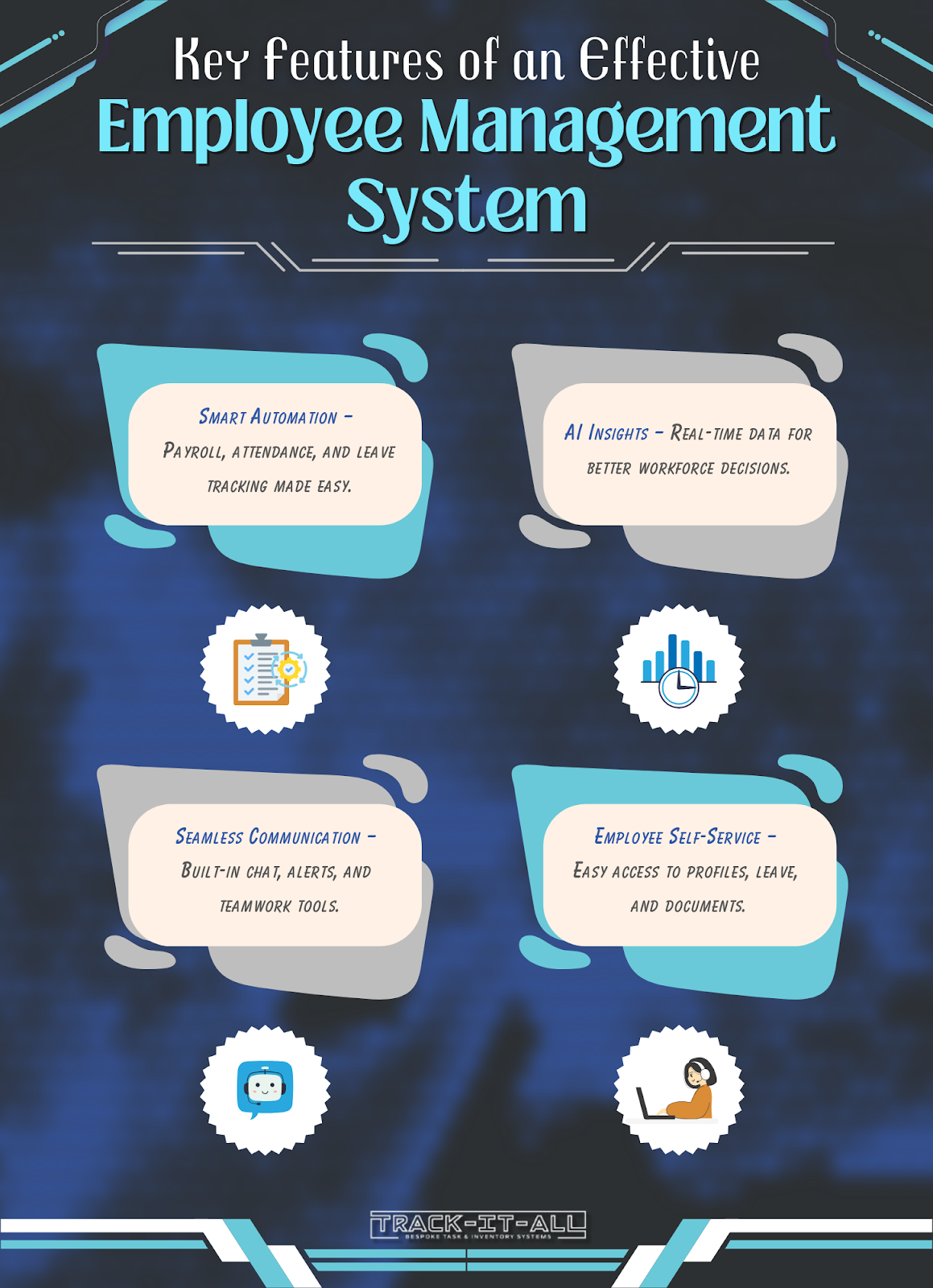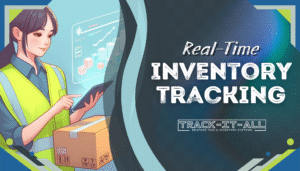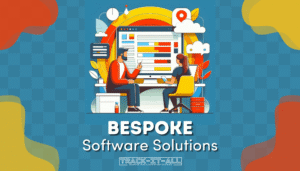The workplace has transformed dramatically over the past few years. With trends like remote work, the Great Resignation, and the increasing focus on employee engagement, businesses are struggling to manage their workforce effectively. HR professionals and business owners need smarter ways to handle payroll, performance management, and workforce productivity.
This is where an Employee Management System (EMS) comes in. Once a simple database for tracking employee information, it has now evolved into a comprehensive management tool that helps organizations automate HR processes, track employee performance, and improve workforce management. In 2025, an EMS is more than just an HR management platform; it is a strategic asset that helps businesses enhance their productivity, increase employee satisfaction, and create an environment where employees feel valued.
At Track-It-All (https://track-it-all.co.za/), we specialize in a cloud-based employee management system that helps businesses manage employees, optimize workflow, and automate essential HR processes. Our management software is designed to enhance business objectives and streamline work management across various industries.
The Evolving Role of the EMS (Beyond Basic Functionality)
Then: Traditional EMS
Earlier management systems were primarily used for payroll management, leave management, and storing basic employee data. While these functions were necessary, they lacked the ability to enhance productivity management or improve employee experience.
Now: Current EMS Capabilities
Modern management software has transformed how companies manage their workforce. Today’s EMS solutions include performance reviews, talent acquisition, onboarding, and project management features. They also integrate with resource management platforms to give businesses a more comprehensive employee management solution.
Key Features of an Effective Employee Management System

Future: 2025 and Beyond
By 2025, EMS platforms will leverage advanced automation and AI-driven analytics to improve performance management and employee engagement. Key advancements include:
- AI and Automation: HR teams will use AI-powered tools to streamline administrative tasks like payroll, time tracking, and employee onboarding.
- Data-Driven Insights: Advanced analytics will help HR professionals understand productive and non-productive hours and gain insights about the top working employees.
- Integration with Business Systems: Seamless compatibility with CRM, project management, and workforce management platforms.
- Skills Management: Tracking skills, identifying skills gaps, and facilitating upskilling initiatives.
- Mobile-First and Remote-Friendly: Ensuring real-time access to employee management tools, whether in the office or working remotely.
Key Benefits of a Modern EMS (A 2025 Perspective)
A best employee management system offers significant advantages, including:
- Increased Efficiency and Productivity: Automating routine tasks helps businesses focus on growth rather than manual processes.
- Improved Employee Experience: Employees feel valued with personalized dashboards and career growth tools.
- Strategic Talent Management: Identifies top performers and supports leadership development.
- Data-Driven Decision Making: Helps HR departments measure HR ROI and plan workforce strategies.
- Enhanced Compliance and Risk Management: Ensures compliance with labor laws and secures employee data with data encryption.
- Cost Savings: Reduces overhead by streamlining workforce management and payroll processes.
- Better Collaboration and Communication: Enhances engagement among team members and management.
How EMS Transforms Employee Experience
A well-designed employee management system does more than just handle HR processes; it actively enhances the employee experience.
- Onboarding Experience: A smooth employee onboarding process ensures new hires feel welcome and prepared for their roles.
- Career Development and Training: Performance management tools track progress and provide personalized learning paths.
- Feedback and Recognition: EMS platforms enable performance reviews, ensuring employees receive the feedback needed for growth.
- Work-Life Balance: Features like time tracking and leave management help maintain a healthy balance between work and personal life.
Practical Considerations for Choosing an EMS in 2025
When selecting an employee management solution, businesses should consider:
- Cloud-Based vs. On-Premise: A cloud-based management solution offers flexibility and easy scalability.
- Integration Capabilities: The system should connect with existing HR software and project management platforms.
- User Experience: A user-friendly interface ensures that HR teams and employees can use it effectively.
- Security and Privacy: Protecting employee data management with encryption and compliance features.
- Cost and ROI: Evaluating the benefits of using an EMS against the investment.

Real-World Example: Track-It-All’s EMS
Many businesses across various industries rely on Track-It-All to enhance their HR management and workforce productivity. For example:
- A manufacturing company used our EMS to streamline their workflow, reducing administrative burdens and improving operational efficiency.
- A technology startup leveraged our project management tools to track employees’ working hours, ensuring optimal resource allocation.
- A retail business implemented our HR management solution to enhance employee engagement, reduce turnover, and create an environment where employees feel valued.
How to Successfully Implement an EMS in Your Organization
Successfully implementing an employee management system (EMS) requires careful planning, execution, and ongoing optimization. Follow these key steps to ensure a smooth transition:
1. Identify Business Needs and Goals
- Assess current HR processes and identify areas that need improvement.
- Define key objectives such as streamlining payroll, enhancing performance management, or improving employee engagement.
- Align EMS implementation with overall business objectives and growth strategies.
2. Choose the Right EMS Solution
- Evaluate different employee management software based on features, scalability, and integration capabilities.
- Choose between cloud-based or on-premise solutions based on your organization’s needs.
- Ensure the system supports time tracking, leave management, payroll, and workflow automation.
3. Secure Leadership and Employee Buy-In
- Communicate the benefits of using an EMS to HR teams, managers, and employees.
- Provide training and workshops to help your team members adapt to the new system.
- Address concerns about data security, employee information protection, and automation.
4. Integrate with Existing Systems
- Ensure compatibility with existing HR management, project management, and payroll systems.
- Minimize disruptions by implementing the EMS in phases.
5. Monitor, Optimize, and Improve
- Regularly track EMS performance and help improve processes.
- Gather employee feedback and adjust features to enhance employee experience.
- Use analytics to measure workforce productivity and make data-driven improvements.
Frequently Asked Questions (FAQs)
1. What is an Employee Management System, and why does it matter in 2025?
An Employee Management System is a digital solution that streamlines management processes, including timekeeping, payroll, and performance management system tracking. In 2025, these systems are essential for businesses to improve employee productivity and ensure seamless HR operations.
2. What are the key benefits and types of employee management systems?
The benefits and types of employee management systems vary, but they generally include better people management, automated workflows, and enhanced benefits administration. They are used across various industries to simplify HR tasks and boost efficiency.
3. How do employee management systems make organizational tasks easier?
These management systems make it easier to track attendance, control the working hours, and monitor project progress. The software helps managers see who is working on which project, improving accountability and planning.
4. How does an employee management system help in performance tracking?
A performance management system integrated into an employee management tool ensures that businesses can analyze time and productivity levels, provide feedback, and set clear performance goals for employees.
5. Why are data and HR integration important in an employee management system?
A good system helps unify data and HR functions, ensuring seamless tracking of the employee lifecycle, from hiring to retirement. This integration enhances decision-making and compliance.
6. How is employee management software used across various industries and organizations?
Employee management tools help businesses across various industries and across various industries and organizations by streamlining scheduling, payroll, and HR analytics, making business operations more efficient and productive.

Conclusion (Future-Proofing Your Workforce)
The future of work is evolving, and businesses must adapt. A comprehensive employee management system is essential for improving employee satisfaction, ensuring effective management, and supporting business objectives. By embracing a modern EMS, companies can optimize workforce productivity, enhance staff management, and help improve operational efficiency.
At Track-It-All (https://track-it-all.co.za/), we offer software tools that simplify human resource processes, optimize worker management, and provide a management solution tailored to your needs. Contact us today to learn how our employee management software can help your business thrive.







